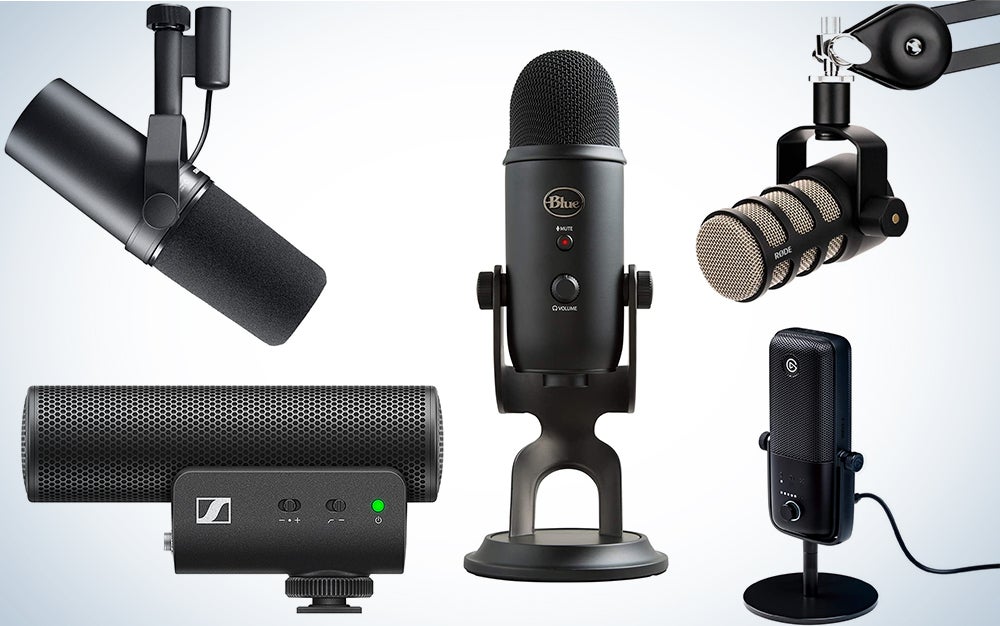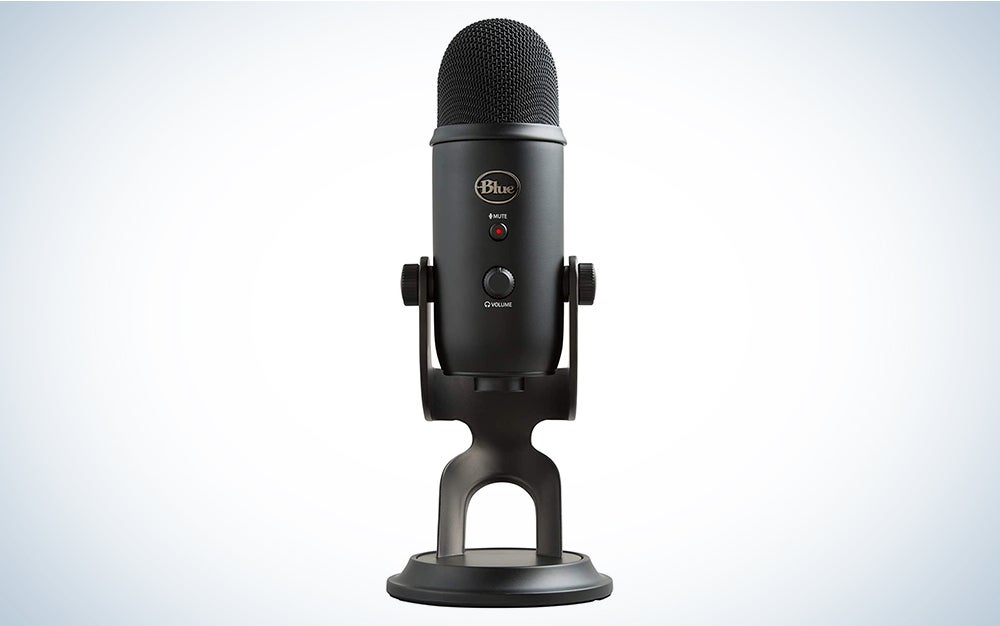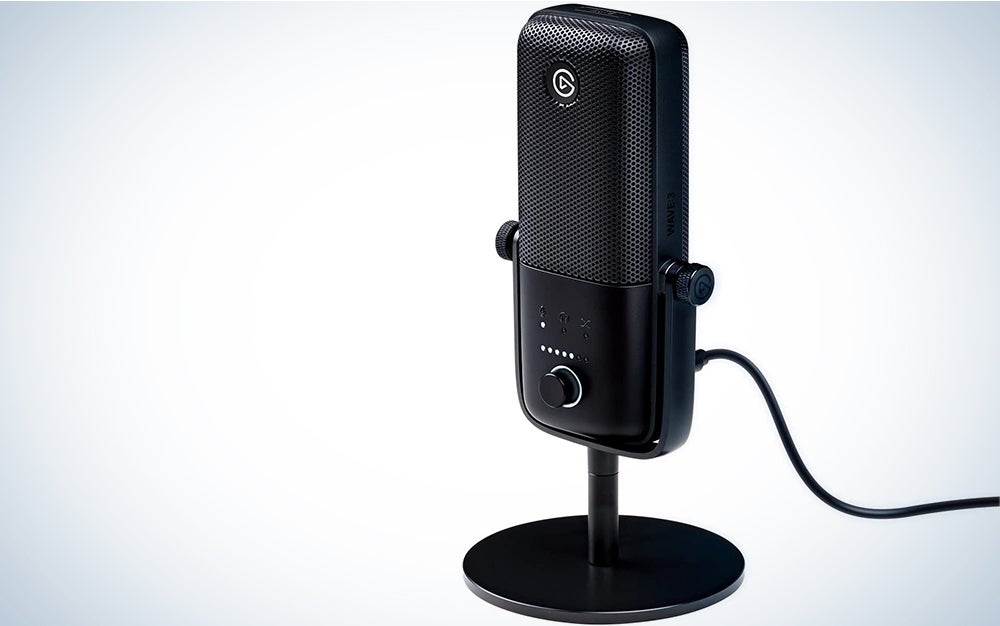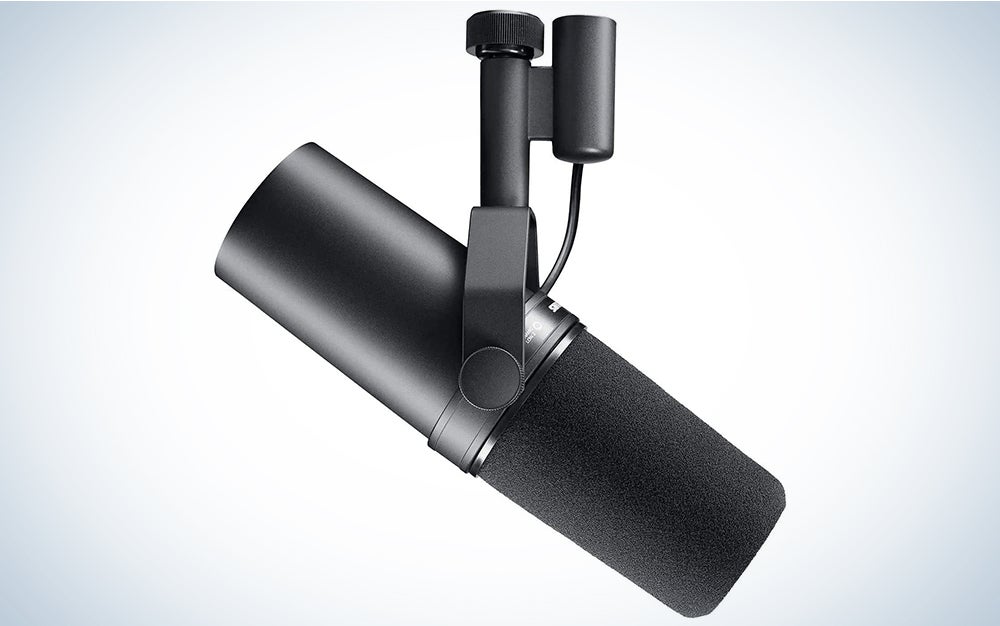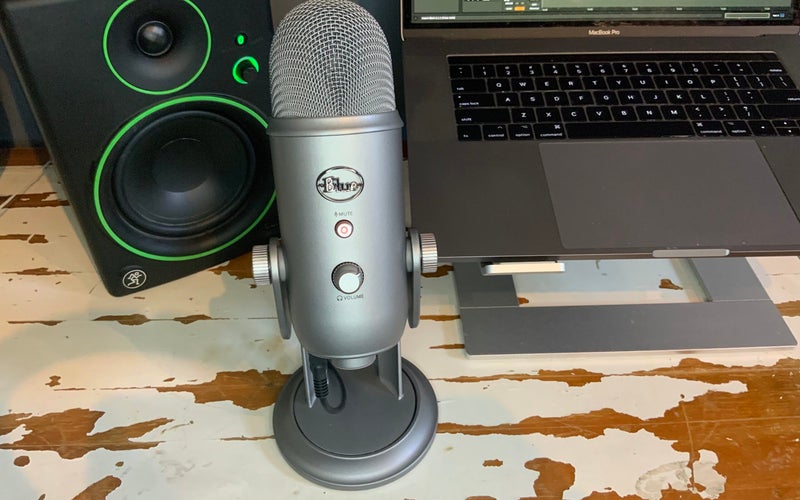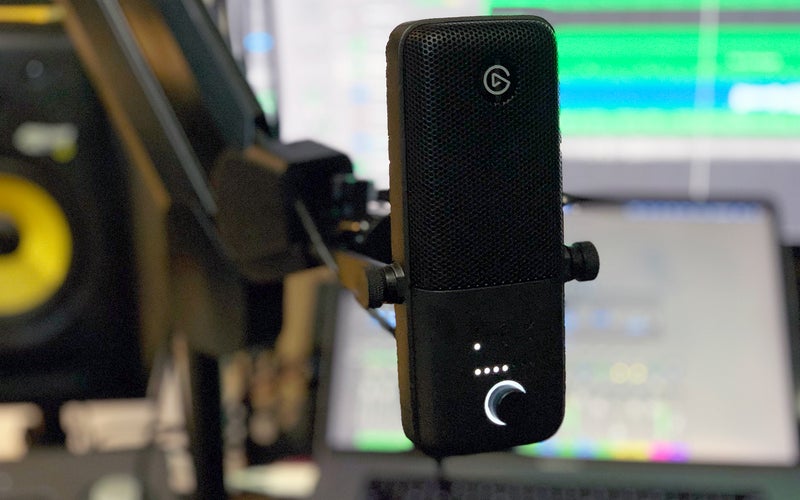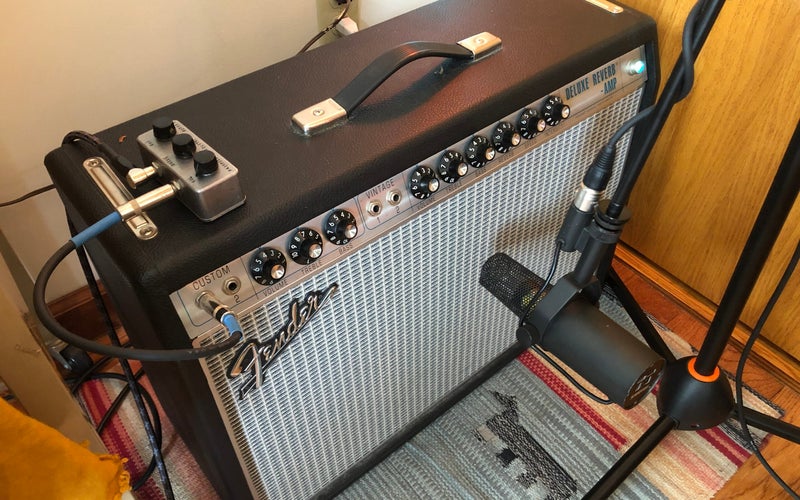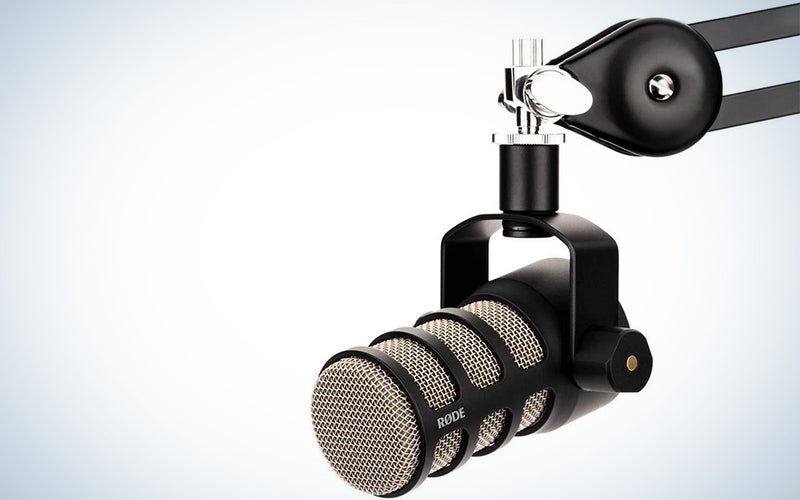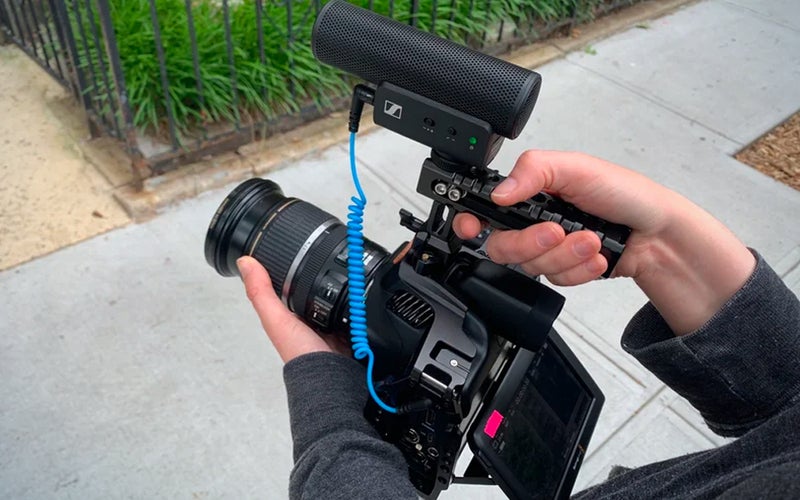We may earn revenue from the products available on this page and participate in affiliate programs. Learn more ›
Most people don’t give a lot of thought to microphones. Those people aren’t livestreaming. For anyone sharing their actions and reactions live on Twitch, YouTube, Facebook Live, etc., a quality standalone mic is one of the most important pieces of equipment you can buy. Long gone are the days when a generic headset or a computer’s tinny built-in mic will do. But not every mic suits every job and the wrong one in your studio can limit your broadcast options or even silence you completely. With the best mics for streaming, however, it’s easy to make your livestream sing—literally, if that’s what you like to do on-air!
- Best overall: Blue Yeti
- Best for multiple sources: Elgato Wave:3
- Best professional: Shure SM7B
- Best budget: Rode PodMic
- Best portable: Sennheiser MKE 400
How we selected the best mics for streaming
The microphone market is saturated with products and choosing the right piece of equipment isn’t always easy. We consulted academic articles and product reviews, we spoke with professionals, and we did our own first-hand testing to find mics whose signals rise above the noise. We focused on microphones designed for different types of streamers, from interviewers to gamers and everyone in between, and evaluated criteria like audio quality, ease-of-use, flexible features, and portability. Finally, while a mic’s aesthetics don’t play a role in how it sounds, we realize that, when livestreaming, your equipment often becomes part of your on-screen persona. All other things being equal, we stuck to nicely designed mics.
The best mics for streaming: Reviews & Recommendations
Not all mics are created equal and navigating an industry swamped with options can leave anyone’s ears ringing. So we performed a few check-check-checks for you and here are our picks for the best mics to stream with.
Best overall: Blue Yeti
Markkus Rovito
Why it made the cut: Blue Microphones has been producing mics for streamers and podcasters for years, and the ubiquitous Yeti’s three condensers and variety of polar patterns make it one of their most versatile models.
Specs:
- Capsules: Three condensers
- Frequency Response: 20 Hz to 20 kHz
- Connector: mini-USB
- Number of Polar Patterns: Four
Pros
- Three condenser capsules
- Four polar patterns for versatility
- Internal headphone monitoring
Cons
- No XLR output
- Not particularly sleek
There’s a great reason you’ll find the Blue Microphones Yeti USB microphone in the studios of many streamers and podcasters: it’s simple to use, versatile, delivers great sound, and costs less than even a D-list cover band’s touring budget. As one of the best mics for streaming this mic combines three separate condenser capsules and has four selectable polar patterns: cardioid, omni, figure-8, and stereo. Its 16-bit/48kHz analog-to-digital converter captures all the expressiveness of the human voice and the mic provides zero-latency monitoring thanks to an internal headphone amp and output (with its own volume knob). An input gain control keeps louder sound sources under control and you can use the mute switch whenever discussing something you don’t want your listeners to hear—or you just need to sneeze. The Yeti’s USB output makes connecting it to a computer simple and the microphone sits on your desk using its included stand. If your setup is more modular, you can also mount the Yeti to a swing-arm using the threaded connector set into its housing. And, as an added bonus for any streamers who like to keep their mics in sight of the camera, the standard Yeti comes in a variety of colors—including blue, silver, teal, red, and black.
For even more on-screen impact, consider the HyperX QuadCast S—which we reviewed here—a gaming microphone with customizable RGB lighting. Or, if you’re good with the general look of the Blue Yeti but want some subtle visual flair and a bump in audio clarity, consider the newer, slightly more expensive Yeti X (learn more about the differences here).
Best for multiple sources: Elgato Wave:3
Markkus Rovito
Why it made the cut: The Wave:3’s Clipguard technology helps stop bad audio from ruining your stream by preventing the mic from distorting when you get too loud.
Specs:
- Capsules: One condensers
- Frequency Response: 70 Hz to 20 kHz
- Connector: USB-C
- Number of Polar Patterns: One
Pros
- Clipguard technology helps prevent distorted audio
- USB-C output is compatible with modern laptops
- Integrates seamlessly with Wave Link software mixer
Cons
- Only has a single condenser capsule
- Polar pattern is limited to cardioid
- Needs a separate shock-mount to attach it to a swing-arm
The Elgato Wave:3 is an innovative streaming and podcast microphone that connects seamlessly to Wave Link, Elgato’s digital mixing platform for both Windows and Mac OS. The classy-looking, rectangular mic has one condenser capsule and a fixed cardioid polar pattern, but the audio that comes from it is at a high-quality 96kHz/24-bit resolution. An internal pop-filter helps cut down on those plosives—the hard P’s and B’s that make your audience’s speakers shake—while the company’s proprietary Clipguard technology allows you to rant and rave as loudly as you’d like without the mic distorting. Those are great features, but what really sells the mic is the included Wave Link software, which allows you to combine audio from eight sources—like video games, voice chats, music, alerts, samples, or other mics—into a single broadcast. All in all, this is an elegant solution if you’re building more complex streams.
Best for professionals: Shure SM7B
Jay Cabrera
Why it made the cut: The SM7B’s single, dynamic microphone capsule has a cardioid response pattern that accurately captures your voice while helping to reject off-axis, ambient sounds.
Specs:
- Capsules: One dynamic
- Frequency Response: 50 Hz to 20 kHz
- Connector: XLR
- Number of Polar Patterns: One
Pros
- Dynamic capsule’s frequency range captures some of the best vocal tone
- Cardioid response pattern helps reject background noise
- Integrates yoke makes mounting the mic easy
Cons
- No USB
- More expensive than most streaming mics
- XLR output requires a separate audio interface
- Single cardioid pattern limits versatility
Shure has been a leader in professional-grade stage and studio microphones since 1925 and the company’s products, like the venerable SM58, have graced the performances of divas, pop stars, and heavy-metal gods; recorded instruments on best-selling records; and found a home in broadcast booths worldwide, which is exactly where you’ll find the SM7B. Whether you’re trying to create the rich, honeyed tones of a public radio host or you frequently burst out into raucous song during your livestream, the SM7B’s dynamic capsule is a recording microphone set to receive the goods. Undoubtedly the best studio microphone of our choices, it handles high volumes across a wide frequency range without distortion and its cardioid polar pattern keeps your voice front-and-center in the mix while rejecting surrounding chatter. It’s easy to tailor your sound using the SM7B’s built-in toggles for bass rolloff and presence. However, the SM7B uses a professional XLR microphone connector, which means you’ll need to make sure you’ve got an audio interface like the Red Scarlett 2i2, or a mixer with a USB output, like Roland GO:MIXER PRO-X, in order to get sound into your computer. So your investment requires further investment. Space and budget a little tight? Another great option that shares some of the SM7B’s pedigree, but adds USB, is the Shure MV7 (read our full thoughts on it here).
Best budget: Rode PodMic
Rode
Why it made the cut: Rode’s PodMic captures the rich tones of a dynamic microphone but without the accompanying cost.
Specs:
- Capsules: One dynamic
- Frequency Response: 20 Hz to 20 kHz
- Connector: XLR
- Number of Polar Patterns: One
Pros
- Wide 20 Hz to 20 kHz frequency response
- Robust dynamic capsule
- Much less expensive than other dynamic mics
Cons
- Thinner sounding than some of the higher-end dynamic mics
- XLR connector requires an audio interface to connect to the computer
Sometimes, you have a PC with a purpose and sometimes you want a jack of all trades. The same can be true of your speakers. Rode has worked hard over the years to establish itself as a purveyor of high-quality, budget-friendly microphones and today its products are found in professional settings all over the world. So it’s not surprising that this dynamic microphone captures the warm sounds of pro broadcasters without emptying your wallet. Its single capsule has a cardioid polar pattern that focuses the listener on your voice while holding ambient noise at bay. Rode describes the PodMic as optimized for use with the company’s RodeCaster Pro Podcast production studio—an external mixer and recording unit with four inputs—but the microphone’s professional, balanced XLR output connects to any audio interface for use with a computer. It also can plug directly into field recording units, video cameras, or professional mixers.
Best portable: Sennheiser MKE 400
Brian S. Hawkins
Why it made the cut: The supercardioid polar pattern is specifically designed to reject a fair amount of noise from anywhere but directly in front of the mic, making the mic excellent for use in noisy environments.
Specs:
- Capsules: One condensers
- Frequency Response: 50 Hz to 20 kHz
- Connector: TRS or TRRS
- Number of Polar Patterns: One
Pros
- Supercardioid polar pattern rejects unwanted sound
- TRRS connector works with iOS and Android mobile devices
- Small and lightweight
Cons
- Audio quality isn’t as rich as higher-end options
- Requires AAA batteries
- Somewhat awkward output jack placement
Sennheiser makes some of the best microphones in the world, go-to equipment for audio professionals across a wide range of industries. The German company’s MKE 400 compact shotgun microphone (read our full review here) is small enough to sit comfortably on smartphones—using the included phone mount—or compact cameras using the built-in cold-shoe. It features TRRS connectivity so you can attach it to an iOS or Android device without losing access to your phone and also comes with a TRS connector for use with cameras, micro-mixers with TRS inputs, or full-size mixers and audio interfaces using third-party TRS to ¼-inch adapters. The MKE 400 is known as a shotgun microphone because of its single-condenser interface and supercardioid polar pattern that offers extreme rejection of noise from the sides—these types of mics do a great job of keeping the focus on whatever they’re pointed at. The MKE 400 includes switches for gain boost and cut, a bass rolloff switch, plus a zero-latency headphone output jack and dedicated volume control. It comes with a tripod and phone holder for easy positioning on a desk or for use as a handle when shooting livestreams in the field.
What to consider when shopping for the best mics for streaming
All the top microphones will deliver high-quality audio, but mics still differ in various ways. When shopping for a streaming microphone, think about the kind of show you’re streaming and what sort of features the mic can bring to your production values. Make sure you understand the ins and outs of how different pickup (or “polar”) patterns, microphone capsules, and connections work so you won’t have to worry about downtime while your audience numbers dwindle. Remember, with microphones you get what you pay for—they don’t have to cost as much as a car to do their job, but beware the flood of budget-oriented, low-quality mics popping up online. Stick to brands that have established reputations in the audio marketplace.
A pattern of use
Different microphones are designed to capture sound waves from different positions. Cardioid mics pick up sound sources right in front of them and are great for use in the broadcast booth or when only one person’s speaking. Mics with omni patterns respond well to people clustered around it—use them if you’re streaming the conversation at a party or you want to pick up all the ambient noise at an event to help your listeners feel like they’re on the scene. Mics with figure-8 patterns are ideal for interviews; they pick up voices on either side, and reject a lot of the surrounding noise. Many mics have one polar pattern, but a company like Blue makes theirs with the ability to switch the range of the mic’s response.
Types of mics
Generally speaking, the best mics come in two flavors: condenser and dynamic capsules. Many streamers prefer the best condenser mics because they’re great for capturing quiet sounds and subtle nuances. They’re also usually available in a wider range of polar patterns. On the other hand, they can be delicate, don’t do a very good job with loud noises, and also require power from either an internal battery or through a USB connection or a source that can deliver 48v phantom power. Dynamic mics, on the other hand, are robust tools that hold up well to high volumes—and rougher handling. They often have a cardioid polar pattern that does an excellent job rejecting background noise, which is why they commonly turn up in the hands of stage performers and field reporters. These are excellent mics if you’re streaming from a noisy household, comic convention, or bustling office. It’s harder to find them with USB connections, though, which makes them a bit trickier to slide into your audio chain. It’s worth noting that dynamic mics often have a warmer sound, which is one reason radio broadcasters deliver their schtick in such dulcet tones. If you want a more naturalistic sound, it might be worth looking at condenser mics.
On the road again
Streaming tech has reached a point where it’s easy to broadcast live using just a smartphone with a solid LTE or WiFi connection. If you’re traveling, look for small, lightweight mics that can connect to your device via its TRRS jack, or USB or Lightning ports. These mics usually have an extremely directional supercardioid or hypercardioid pattern—they’re colloquially known as shotgun mics—so that when you point them at yourself for a selfie walk-and-talk, pesky environmental noise won’t screw up your stream. It’s worth considering keeping one in your backpack and using a different mic in your home studio.
If you often stream from the road, consider pairing your mic with a micro-mixer like the Roland GO:MIXER PRO-X. This pocket-size mixer has nine audio inputs and connects directly to an iOS or Android device so you can record not only yourself, but also collaborators, musicians, or anyone else.
Making a connection
Microphones can plug directly into most computers via USB or, sometimes, using a traditional audio cable that connects to a USB audio interface. If you’ve got multiple audio sources, a mixer is handy—some have USB outs themselves, while others will also need to plug into an audio interface. While a USB connection is convenient, it does limit the mic to the digital world. If you want to use the mic in other applications, it needs to have an analog output such as balanced XLR or TRS.
FAQs
Q: Do you need a mic to stream on Twitch?
You don’t need a mic to stream video on Twitch. But do you want to be heard? Anytime you want to stream your voice, you’ll need a microphone. It’s how the soundwaves coming from your mouth are captured and turned into electronic impulses. Your streaming platform of choice doesn’t matter if you’re not feeding it your voice.
Q: Should I use a headset or microphone for streaming?
Whether you choose a headset and a standalone microphone for streaming depends greatly on how you plan on using it. Headsets offer freedom of movement because the mic is always with you. But often standalone microphones have better audio quality. They’re also the only way to go if you’re going to have more than one person on your stream (and not everyone’s wearing a headset).
Q: Where should I put the microphone for streaming?
Generally, you want to place your mic about 1 foot to 18 inches away from and directly in front of you. Position it so the capsule is facing your mouth—you don’t want to be off at too much of an angle. This is especially true if you’re using a condenser with a supercardioid polar pattern. Mics always perform their best with an audio source that’s directly in front of them.
Final word on picking the best mics for streaming
- Best overall: Blue Yeti
- Best for multiple sources: Elgato Wave:3
- Best professional: Shure SM7B
- Best budget: Rode PodMic
- Best portable: Sennheiser MKE 400
The best mic for streaming is an investment that will serve you well for as long as you stay on the air. If you have clear goals for your streaming, try to find a mic that helps you accomplish them even as you and your online identity grow. But also consider multiple mics for different situations; sometimes the best streaming microphone in the studio or while you’re gaming isn’t ideal for taking to a festival or industry event. In the end, when buying equipment, remember the value of research. Read reviews, consult our guides, and don’t forget to find out what your favorite podcasters are using. Then get out there and make some noise.
Why trust us
Popular Science started writing about technology more than 150 years ago. There was no such thing as “gadget writing” when we published our first issue in 1872, but if there was, our mission to demystify the world of innovation for everyday readers means we would have been all over it. Here in the present, PopSci is fully committed to helping readers navigate the increasingly intimidating array of devices on the market right now.
Our writers and editors have combined decades of experience covering and reviewing consumer electronics. We each have our own obsessive specialties—from high-end audio to video games to cameras and beyond—but when we’re reviewing devices outside of our immediate wheelhouses, we do our best to seek out trustworthy voices and opinions to help guide people to the very best recommendations. We know we don’t know everything, but we’re excited to live through the analysis paralysis that internet shopping can spur so readers don’t have to.
